For our first Festival Friday post, we’ll take you to Ivrea in northern Italy, home of one of the craziest Carnival traditions in the world – the Battle of the Oranges!
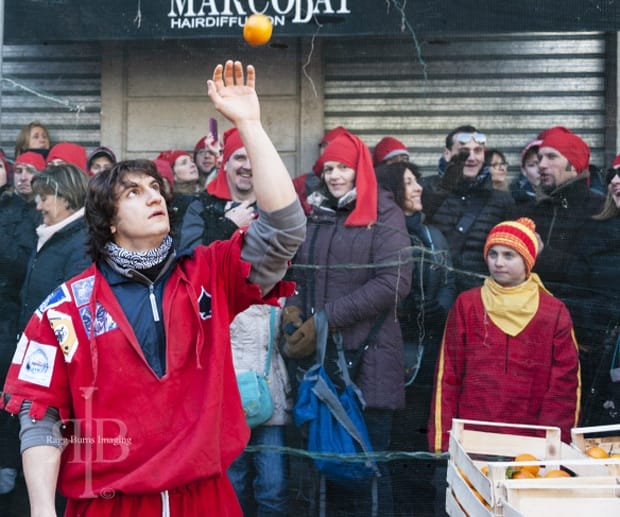
Battle of the Oranges in action
All I can see is a flash of orange, then I am hit in the chest. It knocks my breath away. I slide backwards, fall bum-first in a pile of orange mush. What the heck? I touch my head: my red hat is still there.
During Carnival, official public notices are plastered on the walls around Ivrea, ordering people, especially tourists, to wear a red hat. Or else they can be considered a ‘fair target for gentle and moderate orange-throwing’.
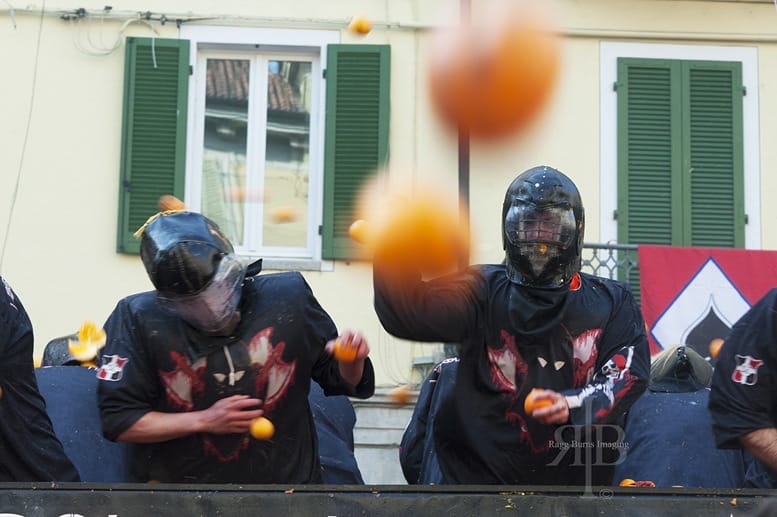
The red hat people are ordered to wear is not just any hat. The berretto frigio, a sock-shaped hat sold on every street corner, is the symbol of the carnival itself. It is a symbol of freedom; worn in Roman times by freed slaves, during the Middle Ages it was on the heads of peasants rioting against feudal lords.
Back on my feet, I make sure my hat is on, and visible. I want to get another look, but soon I am hit again. On my forehead. My head jerks back, I wipe my face, oh my goodness, it’s blood! I am going to need stitches, maybe it’s a concussion?
Then I remember blood oranges.
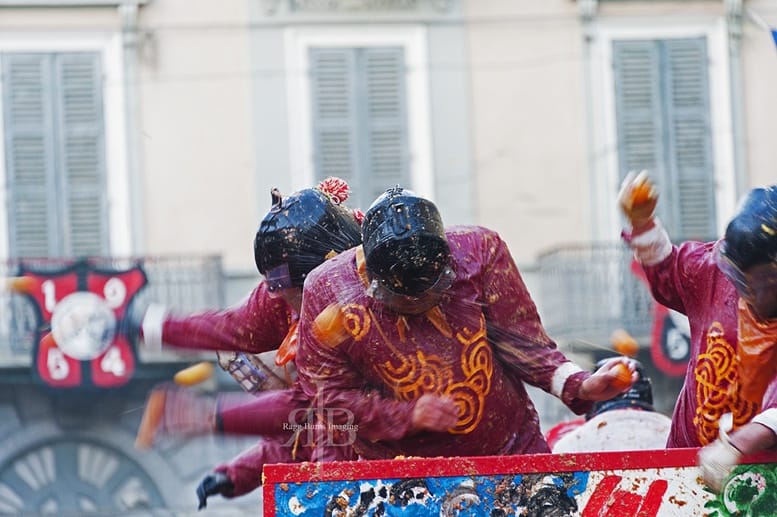
Shivering from the quick succession of shock and relief, I retreat to the back of the square, away from any flying fruit. This is the first of three yearly battles; everybody is fresh and excited from a year-long wait. Nine teams of aranceri (orange-throwers) on foot, wearing uniforms, hurl oranges at their opponents on horse-drawn carriages, clad in Doctor Whoesque costumes with padded shoulders and leather-covered cylindrical helmets. An hour into the battle, the square is covered in a thick sludge, mixture of orange pulp and horse manure. It smells sharp, sweet-and-sour.
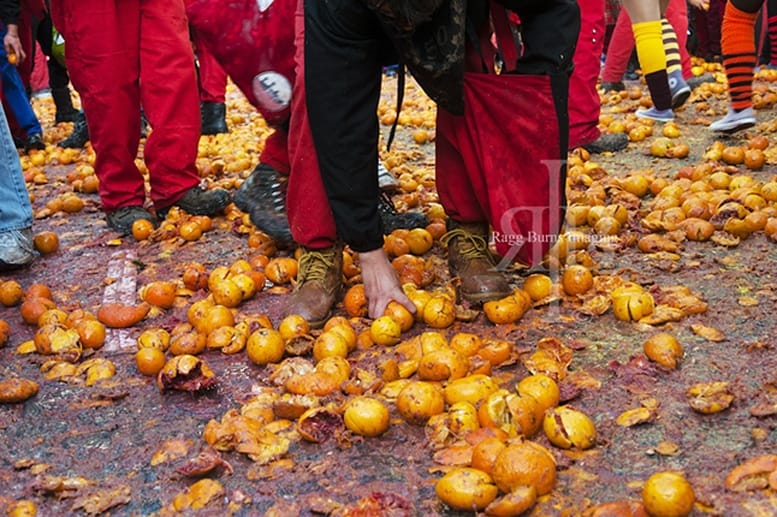
The people of Ivrea
Aranceri on foot rush back and forth, to the sides of the square stacked with orange crates, filling their shoulder bags and baggy tops. As soon as a cart approaches, they charge, bombarding it with oranges. Horses halt, for a few minutes; oranges explode, then the cart takes off again, the aranceri chase it for a while, hurling the last of their supplies. They wear no protection, and walk around with their hair caked in orange bits, juice running down their faces. Some have broken noses, some clutch a side of their face, arms or ribs. They held their heads high, shouting their team’s war cries.
“This is the moment we wait for all year” says Silvia, holding an orange cut in half on her right eye. “I’ll be happy to have a black eye tomorrow.”

She sits with me, sipping a glass of mulled wine. “I think carnival is good for our psychological health. During these three days I can let it all out, all the frustrations I have built up during the year. After I feel refreshed. Of course, accidents happen” she adds, pushing the orange on her swollen eye. “But you should try, it’s good for you”.
I am curious to know what it feels, I admit. I keep thinking I am wearing a hat, and the public not supposed to join in the battle. Even so, that doesn’t seem to stop hat-wearers from throwing the occasional orange. To prevent further trouble, volunteers advise the public to stay behind protective nets.
“Forget the nets” says Massi, an arancere of the Morte team, with a gigantic skull on the back of his orange-stained uniform. “If you want to live the carnival, you have to be in the middle of the battle.”
“Aren’t you afraid of getting hurt?”
Massi laughs. “If you compare the risk to the rush you get, a black eye is a small price to pay.”
He fills his top with oranges. A cart is approaching. “Come on, throw your red hat away and come with me”.
I am tempted, but I decline.

Battle of the Oranges history
The carnival is the celebration of a medieval rebellion. Feudal lords had the right of sleeping with brides on their first wedding night. The beautiful miller Violetta promised her fiancé she would refuse to subdue. Alone with the lord in his chambers, Violetta extracted a dagger and beheaded him, then showed the head to the people standing around the castle walls.
This event sparked a revolt; the castle was set on fire and the people marched victorious, led by their heroine. During the battle of the oranges, the aranceri on foot represent the people, the lord’s army are those on horse-drawn carriages, whose protections are supposed to be reminiscent of Medieval armours. Over the centuries, the legend changed time and time again, including dozens more historical characters from different epochs, but, as the locals say, the bottom line is one: revolution.

Why does Battle of the Oranges still take place?
Why do people throw oranges? There is no official answer. The most likely theory defines the battle as an evolution of the 19th-century custom of throwing oranges, then considered an exotic fruit, to official parades as a sign of respect. How that became a battle, no-one knows. Nowadays, the battle draws to Ivrea hundreds of thousands of visitors each year. Three thousand tonnes of oranges are thrown during the three days of Carnival. After the battle, they are processed into compost.
I run into Silvia again, as the battle is winding down. “You’ve got to have a go at throwing, it’s your last chance” she says, dragging me towards the crates. She hands me a shoulder bag, bulging with oranges. “Don’t worry, just throw.”
I stuff my red hat in my pocket, follow Silvia towards the approaching cart. All I can hear is the whomp of oranges crashing. I start throwing. At first I am careful, but the melee is such that I just get caught, I am hit in the head, chest, neck and stomach, but I don’t feel any pain. I feel light. It’s liberating. The atmosphere is charged; the masked characters become my frustrations, the people that made me angry during the years. The teacher who threw me out of high school. The boss who sacked me. The girl who stole my boyfriend. The government.
The bag is empty. I pick up handfuls of orange mush on the floor and keep throwing. Silvia pulls on my sleeve. “Calm down, the cart’s gone. So, what did I say? It’s good, isn’t it? I bet you’re coming back next year.”
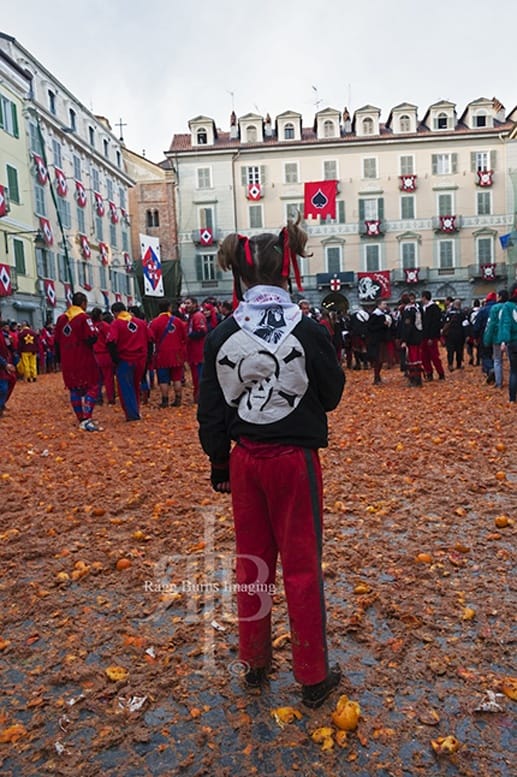
Where is Ivrea?
Practical Info: Ivrea is about an hour north of Turin. There are hourly buses and trains between the cities. Carnival dates change every year, check the official event website for more information. Battles of the Oranges are on Carnival Sunday, Monday and Tuesday. Ivrea has a very active couchsurfing community, and it is thanks to them that we were able to have such an amazing experience. Thanks guys!
For more crazy Carnival stories from around the world, read our Gualeguaychu Carnival and our Carnevale di Venezia posts!
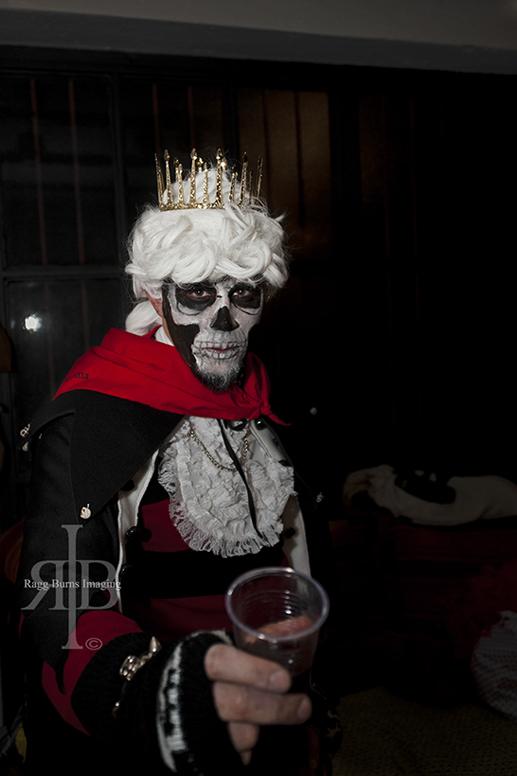
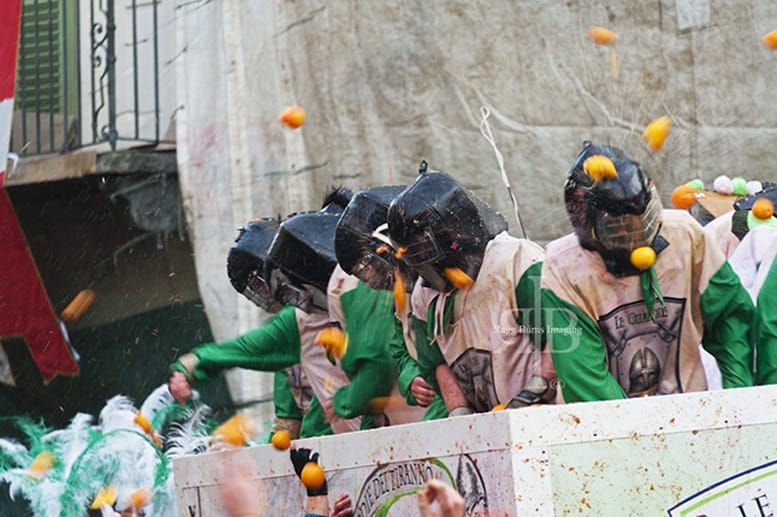
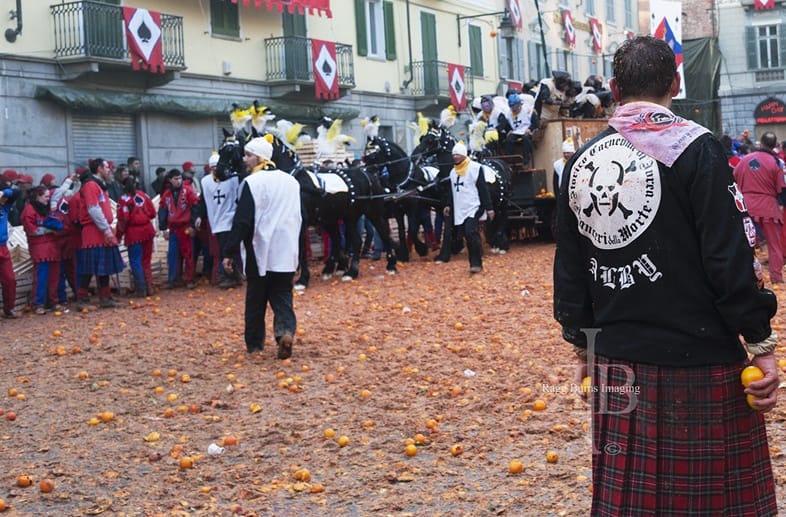
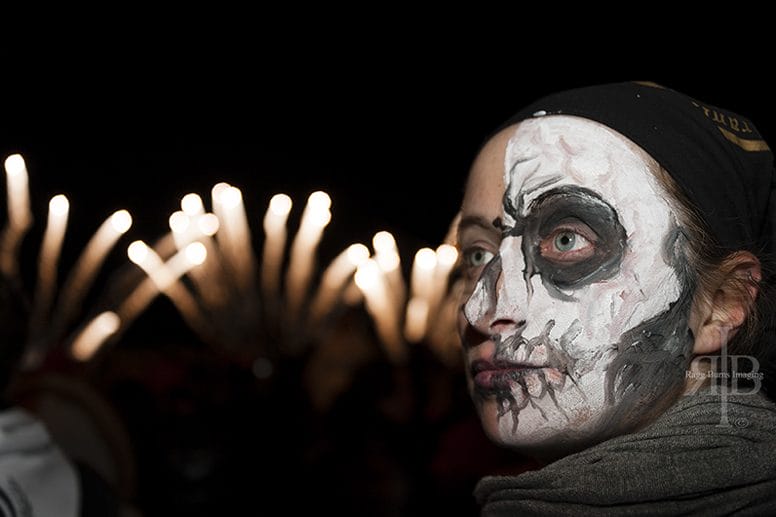

That sounds like a lot of fun, but also kinda painful haha. It’s interesting, there are so many funky traditions like these all over the world. Had never heard about this orange one, thank you for sharing!
Thanks Claus! It’s definitely worth a visit… the Carnival I visited was quite early (around mid-feb) so the oranges were half frozen! A late carnival may be less painful lol. How do you celebrate Carnival in Canada?